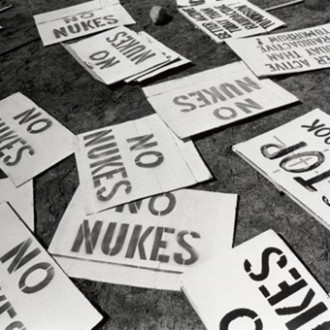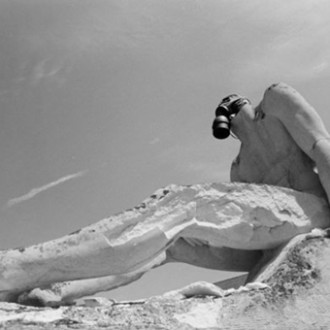“Lionel Delevingne’s photographs beautifully depict the people whose everyday lives were dramatically overturned by the technological Goliath of nuclear power. Only time will tell if their voices will be heeded, but their story and their fight will live forever within the pages of To the Village Square. It is a compelling documentation of a movement that sadly is as needed today as it was forty years ago.”
Pamela Lippe– President and Executive Director Earth Day New York.
“This is an extraordinary book documenting the vitally-important battle that has now been waged for decades against nuclear power and for safe, clean energy.. Moreover, as Lionel Delevingne says, his “book is about power. Not just nuclear power but, as I have witnessed, the power of community to force action and make a change.” He has done a remarkable job in chronicling the power of people in challenging nuclear power and campaigning for energy we can live with — while also providing a clear presentation on the deadly dangers of atomic energy.”
Karl Grossman – Professor of Journalism, State University of New York/College at Old Westbury, Host of the Television Program “Enviro Close-Up“. Author of “Cover Up: What You Are Not Supposed to Know About Nuclear Power.”
“Lionel Delevingne’s photographs have captured for all time one of the most significant movements in the modern environmental renaissance: The No Nukes movement in the 1970s, particularly the groundbreaking Seabrook campaign by the Clamshell Alliance. The people of this region set the standard for citizen action in the era of nuclear proliferation. Delevingne’s images portray the power of non-violent citizen direct action to oppose the abuse of power.
Images, specifically photographic images, can change the world. By revealing the power of direct citizen action, Delevingne’s photographs manifest the spirit of social movement and inspire future generations to take action to protect their communities.”
Rex Weyler– author, Greenpeace International co- founder Vancouver, Canada. about Rex Weyler
“It doesn’t seem so long ago that grass-roots opposition to the Seabrook nuclear power plant grew into a mass movement on a national scale, and it wasn’t so long ago that it seemed that the movement had succeeded. But Chernobyl and Fukushima are two of many reminders that the problems recognized in those early days remain — and so the movement too must remain. Lionel Delevingne’s photographs of the organizers and ordinary citizens who stood up in the 1970s, now in the Department of Special Collections at UMass Amherst, testify to the power of a truly democratic movement, but most importantly, they are inspiration for what was and what may still be.”
Robert S. Cox, Head, Special Collections & University Archives – UMass Amherst Libraries
“I couldn’t simply leaf through Lionel Delevingne’s exquisite To the Village Square. To open it is to participate, comprehend and appreciate the extensive, heroic, multi-decade struggle against global damage by nuclear power plants. It celebrates the many concerned and sensible citizens who have built successful, continuing and urgent movements against the high-handed and short-sighted private developers of these risky plants.
For those around from the No-Nukes start, this is a proud history. For younger folks, it’s a realization of the heritage and beauty of this eternal, reasoned, strengthening and constructive defiance. Delevingne’s own introduction modestly claims he’s composed a book about power; it is also a book that stirs us with hope and understanding of choice and conscience and commitment to humankind.”
Mark Kramer—author, founding director (ret.) Nieman Program on Narrative Journalism at Harvard . and Writer-in-residence, Journalism Dept., Boston University .
“Lionel Delevingne’s photographs bring to life the mixture of passion, commitment, tension, playfulness that animated the citizen movement. As a Clamshell Alliance member three things became clear and were reflected in our actions large and small. First, that there was no way that we would allow nuclear power to be imposed upon us despite our Town Meeting votes to the contrary. Second, that nuclear power was a dangerous and inherently unsafe technology linked to nuclear weapons development. Third, that efficiency and renewable energy was the safe and sustainable path forward.
Roy Morrison– Author, Ecological Democracy, http://www.ecocivilization.info
“In this unique and grandiose book, journalist and photographer Lionel Delevingne documents the 40 year old antinuclear movement’s wins, its noble history and best of all its feisty present!”
Anna Mayo, “Grand Mère” of anti-nuclear journalism, former columnist, “Geiger Counter” / The Village Voice, NYC
“Back in the Seventies, Internet was not even a dream and the news took often a long time to travel across the Atlantic. Thanks to the beautiful photographic essays by Lionel Delevingne published in « Le Sauvage », one of the very first ecological magazines in France, we became aware about the growing antinuclear movement in the USA. I am happy that through this book, the story of the mobilisation against the Seabrook reactors is going at last to be revived and known to the young generations.”
Laurent Samuel, journaliste, Paris France. http://www.scoop.it/t/actualites-ecologie/ http://www.mediapeps.org/
“Lionel Delevingne’s thought-provoking and often stunning photographs accurately capture the depth and feeling of the grassroots antinuclear movement in the United States over the past 40 years. Anna Gyorgy’s introduction adds important information about the ongoing worldwide struggle against nuclear technology.
Robin Read, former member of the New Hampshire House of Representatives, Portsmouth, NH
“The No Nukes movement may someday be remembered as history’s most essential non-violent uprising. While shutting down and preventing the construction of hundreds of lethal reactors—each with the power to attack our core existence on this planet—-it has also given birth to what may soon become the world’s largest industry, the Solartopian conversion to renewable green power.
Along the way Lionel Delevingne has been the “family photographer” of an amazing body of people and actions that, against all odds, have created a way for the human race to survive.
Our time together has been joyous, demanding, pathbreaking, exciting, astounding and so much more….all captured on film by the brilliant, loving lens of Lionel Delevingne, and in the beautiful words of Anna Gyorgy’s introduction.
To the Village Square” is the essential passport to four decades of peaceful passion. Don’t miss it!”
Harvey “No Nukes” Wasserman co-wrote the Grammy-winning Solartopia Song” with Pete Seeger and David Bernz. He wrote SOLARTOPIA! OUR GREEN-POWERED EARTH and a dozen other books, and has published many articles on nukes, green energy, politics, etc. since 1965. www.nukefree.org
“To the Village Square is AMAZING and important and moving”.
William C. Newman, Director, American Civil Liberties Union, Western Massachusetts Regional Office.
“Thank you Lionel Delevingne for the noble and beautiful tribute to the dedicated rainbow warriors of the nuclear resistance movement ! To the Village Square! 2015 marks 70n years of atomic madness. The perfect stopping place.”
Glen Carroll, Coordinator Nuclear Watch South, Atlanta, GA
“This book requires that you ponder the speech of each image, as opposed to flipping through, looking at the pictures. Having done that, close your eyes and imagine yourself at a social event, even if it is just learning of some news, that challenged the familiar social fabric of your community. For me, it evoked memories of the anti-war movement borne, at first, with the rejection of white privilege, memories of women finally acquiring a voice, and the infancy of our collective celebration of Earth Day, and having been delivered the institutional tools to slow our assault on Mother Earth. The imagery in this book confronts us, and comforts us with the ingenuity of community deeply rooted in our humanity. We see that we are a community that survives through the touch one generation uses with another to share what is really the glue of our spirits, the need for survival. It is my sincere hope that the resulting dialogue we have, even with just ourselves, about the familiarity of the emotions, and hopes and dreams we see will lead us away from the singularity of focus on dividends and back to heartfelt and thoughtful conversations about our communities and our individual purpose.
Again, close your eyes and imagine all the many times this power in unison became the birthright of a new freedom.”
Mark Siegars, Attorney, Amherst, MA
Links to Interviews and Reviews
- Foreword Magazine‘s Matt Sutherland https://www.forewordreviews.com/reviews/to-the-village-square/
- Gloucester Times, Gloucester, MA review of book and event by Gail Mc Carthy
- JNE ( Journalistes et Ecrivains pour la Nature et l’Ecologie, Paris France “http://jne-asso.org/blogjne/?p=25210
- The Berkshire Record BERK21915, Julie Ruth’s review.
- The Cloud- Larry Clow writes on TVS ” Delivering the message” http://soundnh.com/delivering-message/
- WINK BOOKS “Remarkable books that belong to print” Review by Carla Sinclair.
- BOING BOING !
- Aline Smithson of LENSCRATCH Fine Art Photography Daily
- Berkshire Edge’s Colin Harrington reviews TVS.
- Anna Gyorgy / TVS on the “Burt Cohen Show” – WSCAFM.org – Portsmouth NH
- Lionel live on WGBY’s Connecting Point , Public TV, with host Jim Madigan
- Lionel live on WAMC – NPR with host Joe Donahue http://wamc.org/post/village-square-montague-fukushima-1975-2014
- SPOTLIGHT on ProPhotoDaily by David Schonauer
- Pick of the Week ! WAMC/ Odyssey Books




